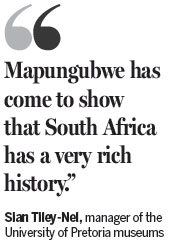Culture war brews over iconic figurine
Updated: 2015-12-19 11:46
By Agence France-Presse in Pretoria, South Africa(China Daily)
|
|||||||||||
Possible loan of artifact to UK museum sparks debate over sophisticated precolonial heritage
For years, South Africa's apartheid government ignored the significance of a "golden rhino" figurine that provides undeniable proof of a sophisticated society existing before white men arrived.
But since the end of racist rule in 1994, the stunning object - just 15 mm long and more than 700 years old - has become a defining symbol of precolonial civilization in South Africa.
Described as southern Africa's equivalent of Tutankhamun's mask, the golden foil rhino could be displayed overseas for the first time in the British Museum at an exhibition of South African art late next year.
With more than 6 million visitors passing through the London museum's doors annually, it would make a dramatic world debut for the rhino, which is currently in a little-known gallery at the University of Pretoria.
The question is whether the South African government will sign off on the loan.
"I think because South Africa has this colonial legacy, people are concerned about heritage objects leaving the country," said Sian Tiley-Nel, manager of the University of Pretoria museums.
"But these are just temporary showcases. They will come back."
After centuries of political, commercial and military exploitation, history in Africa - and who gets to tell it - is a hotly contested subject.

To date, the South African government has declined to say whether the golden rhino will feature as a star exhibit at the London show.
"This matter is still under negotiation and has not been finalized as yet," South Africa's Department of Arts and Culture said.
In 1932, a group of white men hunting for treasure discovered the rhino in Mapungubwe hill, a rocky outcrop in the country's northern Limpopo province, where baobab trees tower over herds of elephant.
They had stumbled across the remains of a graveyard for the elites of a lost kingdom that was a trading hub in 1220, exchanging ivory and gold for glass beads and cloth with Egypt, India and China.
A former student at the University of Pretoria turned over some of the cache to the school.
The rhino and other gold artifacts, including a leopard figurine and necklaces, challenged the colonial version of history that South African civilization started when Dutch colonial administrator Jan van Riebeeck landed in 1652.
"Mapungubwe has come to show that South Africa has a very rich history," said Tiley-Nel, speaking in the dimly lit gallery where the golden rhino is on display. "The southern part of Africa was not an empty myth land."
(China Daily 12/19/2015 page8)
Today's Top News
IMF head ordered to face trial over Tapie affair
China, Russia sign over 30 deals on Medvedev visit
Xi calls for shared future in cyberspace
China successfully launches its first dark matter satellite
China becomes shareholder in European bank
Jeb Bush calls Trump a 'chaos candidate'
French report stresses China's growth offers new opportunities
Reasonable economomic growth rate targeted
Hot Topics
Lunar probe , China growth forecasts, Emission rules get tougher, China seen through 'colored lens', International board,
Editor's Picks

|

|

|

|

|

|






